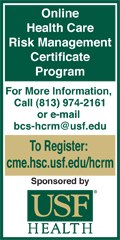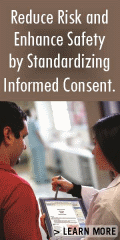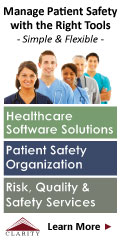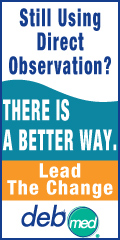 |
 |
 |

November / December 2007

Ensuring Medication Reconciliation
Although the required steps seem basic, the logistics behind when, where, how, and by whom this is done can be difficult
By Kristen Georgia, BS; Kristin Kinney, RN, MSN;

Angela Pace, RN, MSN; and Kim Helton, RN, BSN
Prescription drugs are a vital component of healthcare in preventing and treating illnesses. As the population has aged and chronic conditions have become more manageable, the use of prescription drugs has risen dramatically — adding to the complexity of medication management. From 1994 to 2004, the number of retail prescriptions per capita increased from 7.9 to 12.0 nationally (Henry J. Kaiser Family Foundation, 2005).
Many factors contribute to the difficulty of medication management. These factors include: lack of patient knowledge regarding medication details, multiple care providers including primary care and specialists, multiple sources obtaining different medication lists for the same patient, new Joint Commission requirements, and more. For all these reasons, hospitals are in a difficult position to determine the best method to manage patient medications and therefore, improve patient safety. There is an urgent need to create a consistent, streamlined process that will improve the safety of medication reconciliation during a patient's hospital stay.
Medication reconciliation involves three steps:
- Verification: Collection of a complete and accurate list of the patient's medication history and other medication information.

- Clarification: Ensuring medication and dosages are appropriate for the patient.

- Reconciliation: Resolving discrepancies and documenting changes and new orders (Manno & Hayes, 2006).
Although the required steps seem basic, the logistics behind when, where, how, and by whom this is done can be difficult.
Leading Change
Forrest General Hospital is a 512-bed, level II regional trauma center hospital system located in Hattiesburg, Mississippi. Since quality and safety are high priorities for the organization, the hospital's leadership team decided to proactively address the issue of medication management. Working with a team of experts, they launched a focused initiative to assess the current state of the medication reconciliation process over a 6-week time frame.
Identifying Opportunities and Setting Project Goals
A comprehensive assessment identified key opportunities at the admission, transfer, and discharge points of care. The overall goal was to implement solutions aimed at improving Forrest General's current performance for medication reconciliation. This included the following specific objectives:
- Decrease the number of unreconciled medications.

- Increase use of the "physician's order to resume home medications" form.

- Increase use of the "transfer reconciliation order" form.

- Increase use of the "medication reconciliation discharge" form.

- Decrease medication transcription errors at discharge.
Team Structure and Improvement Methodologies
Three cross-functional project teams were created to focus on admission, transfer, and discharge. Team members included pharmacists, physicians, nurses, and respiratory therapists. Many other departments were represented including the emergency department, education, information technology, and quality management. An executive steering committee was created to lead the project, support the goals and objectives, and remove any barriers.
Throughout this project, the key process improvement methodology used was the Change Acceleration Process (CAP). The seven steps of the CAP model include: Leading Change, Creating a Shared Need, Shaping a Vision, Mobilizing Commitment, Making Change Last, Monitoring Progress, and Changing Systems and Structures. The teams started working to "shape a vision" throughout the hospital by writing an elevator speech. Designed to succinctly address the question, "Why change?", the elevator speech presents a clear statement of the future state and helps gain real commitment.
The teams also used stakeholder analysis to mobilize commitment and identify individuals who have an interest in the process and can have influence over other stakeholders. The team interviewed the stakeholders to find out their position on the upcoming changes before they were implemented. Identifying and mobilizing the stakeholders prior to implementation proved to be instrumental in the project's success.
Developing and Implementing Solutions
Solutions were designed and implemented house-wide, which included all inpatient areas and the emergency department. All three teams used best practices and the new Joint Commission requirements to identify solutions that would have a high impact on improving the process. Key solutions for the admission team included streamlining the process by having the emergency department enter home medications into the electronic system. The initial medication list then rolls to an admitting unit if necessary. The admission team also decided to move the home medication assessment into a separate module in the electronic system to enable early documentation of medications for patients admitted to the hospital. This change enabled home medication to be resumed faster.
By standardizing the location of the home medication assessment, the admission team was able to ensure that the most up-to-date list of home medications was available throughout the entire hospital stay from admission to discharge. The team also created an interview prompter card to standardize the method used to interview patients about their home medications.
The transfer team faced a unique challenge: there was no standard process for reconciling medications during a transfer. The current practice was to handwrite all current orders prior to transfer. In order to create one standard process, the team decided to create and implement a transfer reconciliation order form (similar to the home medication assessment and the discharge medication reconciliation order form) that would allow all orders to be reconciled upon transfers to higher or lower levels of care. This new transfer process would allow physicians who use (computerized physician order entry (CPOE) or physicians who write orders manually (as not all physicians are using CPOE at this time) to successfully reconcile all orders during a transfer. Upon entering a transfer order into the electronic system, physicians using CPOE are now prompted to reconcile all orders. a complete list of all current orders is printed and transferred with the patient to the new unit. Those physicians still writing orders manually complete a similar form by hand. This form is also transferred with the patient to the new unit. Putting this solution in place supported the hospital's goals of eliminating the current copying of orders by physicians and nurses and ensuring that all medications are being reconciled at transfer.
Finally, the discharge team created a number of solutions to improve the medication reconciliation process at discharge. These changes included modifying the discharge medication reconciliation order form to make it user-friendly for physicians and nurses. The team also developed a standard transcription process for creating patient discharge instructions that would decrease the risk of transcription errors.
Ensuring long-term results requires taking steps to sustain the positive changes that have been introduced. In this case, training was key to making change last. During two all-day nursing and unit secretary training sessions, 455 staff members on 19 inpatient units were educated on the new processes. To make the training easy to attend, each nurse/unit secretary took one hour out of his or her day to walk through three different booths; one each for admission, transfer, and discharge. The emergency department staff was trained separately. Physicians were trained in one-on-one sessions and also during departmental meetings. Other departments involved in the process were trained independently.
| Metric |
Before |
After |
| % Medications unreconciled |
Aug: 38%
Sept: 29% |
10% |
| Usage of physician's order to resume home medications |
37% |
70% |
| ED medication documentation |
N/A |
76% |
| Medication reconciliation discharge form utilization |
71.5% |
97% |
| Medication reconciliation transcription error |
58.3% |
10% |
| Transfer reconciliation order form utilization |
N/A |
50% |
|
|
Evaluating the Project's Impact and Sustaining Change
Two months after implementation, the team collected data and began to see significant improvements. The percentage of unreconciled medications was reduced from 38% in August to 10% at the close of the project. Utilization of forms had increased at admission, transfer and discharge. To sustain these improvements and continue to monitor progress, a dashboard was created a including 6 key metrics. Ownership of the metrics was assigned as part of the data collection plan. The dashboard is shared each month with the steering committee, project team, patient care mangers, patient safety committee and quality management committee. The team also created a Failure Modes and Effect Analysis and assigned appropriate ownership. The team also revised the medication reconciliation policy, the current policy for copying orders, and the transfer policy regarding orders for surgical patients. Changes were distributed to appropriate leaders.
Training packets were created and distributed to each floor in the hospital for reference as needed. Training was integrated into the hospital's system for new employee orientation, and to sustain changes for physicians, the teams also incorporated education into physicians' orientation and training. As part of rewards and recognition — key to changing systems and structures — the project team held a celebration luncheon and brought balloons, banners, and flowers to the key pilot units and ancillary departments. Letters of appreciation were sent to all staff members who participated in training. Articles on the project were printed in the hospital's newsletter and the physician newsletter.
Impact and Continued Vigilance
Although the main goal was to improve the medication reconciliation process at Forrest General, the project had additional benefits as well. The team was able to generate executive awareness and involvement in developing the solutions, as well as support to sustain changes. They gained a new perspective regarding comprehensive impact of the project through accountability, metrics, and structure.
There were valuable lessons learned along the way, including the need to ensure strong IT involvement and to seek representation from as many areas of the hospital as possible throughout the project. Attention to the cultural aspects of change clearly paid off. With the cooperation of several key champions, the team was able to steadily gain physician support and acceptance of the new process.
Every worthwhile improvement initiative should include a plan for continuously monitoring progress and ensuring that new or recurring issues are promptly addressed. The medication reconciliation project at Forrest General is no exception. To make sure they remain on track, the team is persisting with efforts to measure results and push for further improvement where warranted.
One of the most important benefits extending beyond this particular initiative was that it enabled multidisciplinary teams to work collaboratively in order to problem solve. By following the steps required to improve medication reconciliation, the team at Forrest General Hospital was able to successfully improve an important aspect of patient care, while also acquiring a new approach to working together and managing change on a daily basis.

County hospital

512 certified beds

More than 2,500 full-time employees

More than 26,000 admissions per year

More than 82,000 ED visits per year

Joint Commission accredited
Key services include general medical & surgical care, general intensive care, cardiac intensive care, cardiology, open-heart surgery, pediatric medical & surgical care, physical rehabilitation, obstetrics, emergency medicine and trauma center.
|
|
Kristen Georgia is a senior consultant with GE Healthcare Performance Solutions. She works with customers on a variety of initiatives, including bed management, perioperative services, emergency department improvement, and mentoring in Lean Six Sigma and change management. She has been with GE since 2000 in various roles. She has a bachelor's of science degree in business. Georgia can reached at Kristen.Georgia@ge.com.
Kristin Kinney is a registered nurse and is a senior consultant with GE Healthcare Performance Solutions, working with the clinical and operational excellence team. Her background is in neonatal intensive care unit nursing, nursing workflow, and nursing and healthcare information technology. Kinney has a master's degree in nursing and healthcare administration. She can be reached at Kristin.Kinney@ge.com.
Angela Pace is the director of quality management services at Forrest General Hospital, where she has been employed since 1982. She is a registered nurse and has a master's degree in nursing. She is a certified professional in healthcare quality and also has clinical experience in diabetes education and neurosurgery. Pace can be reached at apace@forrestgeneral.com.
Kim Helton is the performance improvement/patient safety coordinator at Forrest General Hospital, where she has been employed since 1993. a registered nurse, she has clinical experience is in the areas of home care, medical/surgical, education and critical care. Helton has a bachelor's degree in nursing. She can be reached at khelton@forrestgeneral.com.
References
Henry J. Kaiser Family Foundation. (2005, November). Prescription drug trends.
Manno, M. S., & Hayes, D. D. (2006). How medication reconciliation saves lives. Nursing 36(3), 63-64.
|
 |
 |
 |


















|
 |



